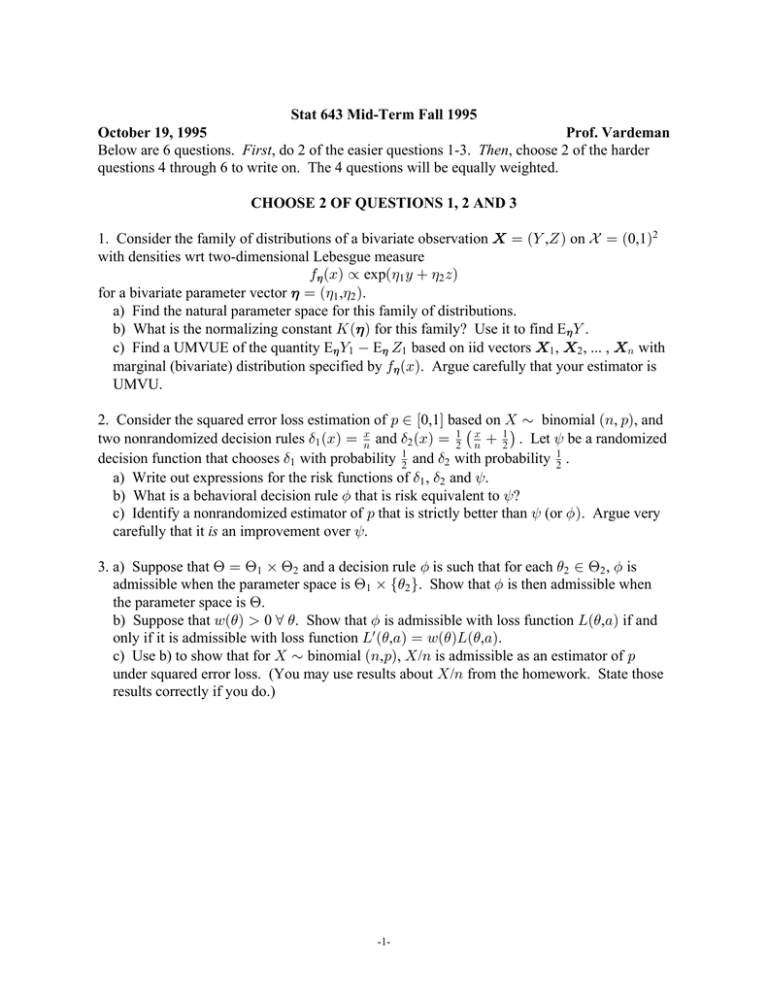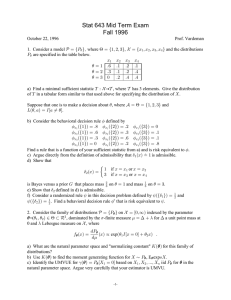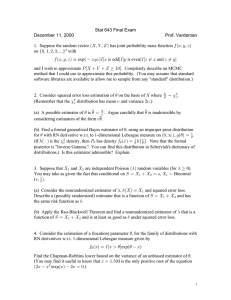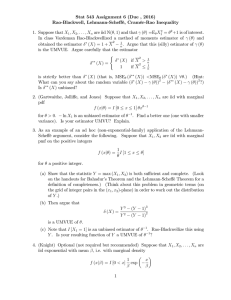Stat 643 Mid-Term Fall 1995 October 19, 1995 Prof. Vardeman
advertisement

Stat 643 Mid-Term Fall 1995 October 19, 1995 Prof. Vardeman Below are 6 questions. First, do 2 of the easier questions 1-3. Then, choose 2 of the harder questions 4 through 6 to write on. The 4 questions will be equally weighted. CHOOSE 2 OF QUESTIONS 1, 2 AND 3 1. Consider the family of distributions of a bivariate observation \ œ Ð] ,^Ñ on k œ Ð0,1Ñ2 with densities wrt two-dimensional Lebesgue measure 0( ÐBÑ º expa(1 C € (2 D b for a bivariate parameter vector ( œ Ð(1 ,(2 Ñ. a) Find the natural parameter space for this family of distributions. b) What is the normalizing constant OÐ(Ñ for this family? Use it to find E( ] . c) Find a UMVUE of the quantity E( ]1 • E( ^1 based on iid vectors \1 , \2 , ... , \8 with marginal (bivariate) distribution specified by 0( ÐBÑ. Argue carefully that your estimator is UMVU. 2. Consider the squared error loss estimation of : - Ò0,1Ó based on \ µ binomial Ð8, :Ñ, and two nonrandomized decision rules $1 ÐBÑ œ 8B and $2 ÐBÑ œ 12 ˆ 8B € 12 ‰ . Let < be a randomized decision function that chooses $1 with probability 12 and $2 with probability 12 . a) Write out expressions for the risk functions of $1 , $2 and <. b) What is a behavioral decision rule 9 that is risk equivalent to <? c) Identify a nonrandomized estimator of : that is strictly better than < (or 9Ñ. Argue very carefully that it is an improvement over <. 3. a) Suppose that @ œ @1 ‚ @2 and a decision rule 9 is such that for each )2 - @2 , 9 is admissible when the parameter space is @1 ‚ Ö)2 ×. Show that 9 is then admissible when the parameter space is @. b) Suppose that AÐ)Ñ ž 0 a ). Show that 9 is admissible with loss function PÐ),+Ñ if and only if it is admissible with loss function Pw Ð),+Ñ œ AÐ)ÑPÐ),+Ñ. c) Use b) to show that for \ µ binomial Ð8,:Ñ, \ /8 is admissible as an estimator of : under squared error loss. (You may use results about \ /8 from the homework. State those results correctly if you do.) -1- CHOOSE 2 OF QUESTIONS 4, 5 AND 6 4. Let T0 and T1 be two distributions on k and 00 and 01 be densities of these wrt some dominating 5-finite measure .. Consider the family of distributions on k indexed by the parameter : - Ò0,1Ó with densities wrt . of the form 0: ÐBÑ œ Ð1 • :Ñ00 ÐBÑ € :01 ÐBÑ . Suppose that \ has density 0: . a) Find the squared error loss Bayes estimator of : for K uniform on Ð0, 1Ñ. b) Argue very carefully that your estimator from a) is admissible. c) If T0 is the binomial Ð8, 14 Ñ distribution and T1 is the binomial Ð8, 34 Ñ distribution, find an ancillary statistic. (Hint: consider the probabilities that \ takes the values 0 and 8.) d) Is the family of distributions with densities 0: necessarily boundedly complete? Explain. 5. Suppose that \ µ Bernoulli (:Ñ and that one wishes to estimate : with loss PÐ:, +Ñ œ | : • + | . Consider the estimator $ with $ Ð0Ñ œ 14 and $ Ð1Ñ œ 34 . a) Write out the risk function for $ and show that VÐ:, $ Ñ Ÿ 14 . (Hint: In showing that VÐ:,$ Ñ Ÿ 14 , consider the risk first on Ò0, 14 Ó, then on Ò 34 , 1Ó and then on Ò 14 , 34 Ó.Ñ b) Show that there is a prior distribution placing all its mass on Ö0, 12 , 1× against which $ is Bayes. c) Prove that $ is minimax in this problem and identify a least favorable prior distribution. 6. In analytical chemistry, measurements of the concentration of a substance are often reported as the measured value if it is above a fixed detection threshold, and as “no detect" otherwise. This problem is meant to treat a simplified version of this kind of situation. Suppose to that end that \ w is exponential with mean -•1 (i.e. has density 0- ÐBÑ œ -expÐ • -BÑMÒB 0Ó wrt Lebesgue measure) but that what one observes is \ œ \ w MÒ\ w ž 1Ó. (The threshold in this problem is 1 and if \ w is not above 1, the value recorded is 0, indicating a “no detect".) a) Consider the measure . on k œ Ö0× • Ð1,_Ñ consisting of a point mass of 1 at 0, plus Lebesgue measure on Ð1,_Ñ. Give a formula for an R-N derivative of T-\ wrt . on k . b) Suppose that \1 , \2 , ... , \8 are iid with marginal distribution T-\ . Find a twodimensional sufficient statistic for this problem and argue that it is indeed sufficient. c) Explain carefully why you can not invoke standard two dimensional “exponential family" results here to conclude that your statistic from b) is complete. What jargon is used to describe families of distributions like the one in this problem? d) Carefully argue that your statistic from b) is minimal sufficient. (Careful ... I don't see how to apply Bahadur's Theorem and one of the other two methods for showing minimality gets pretty ugly.) -2-








